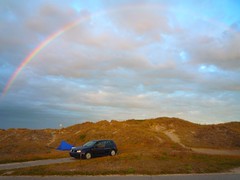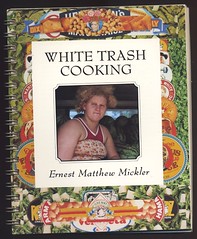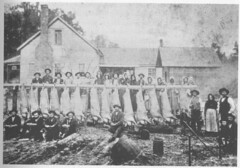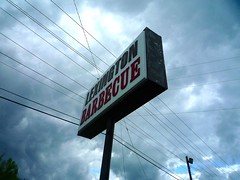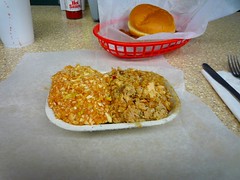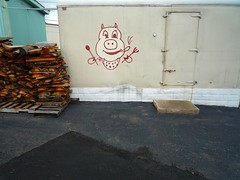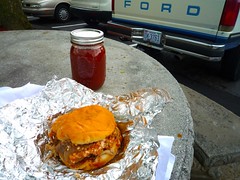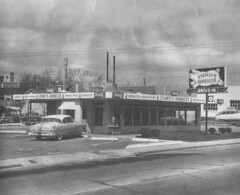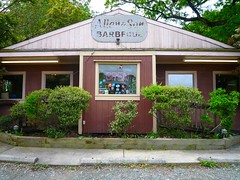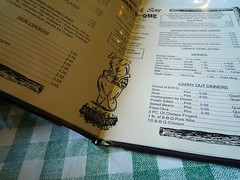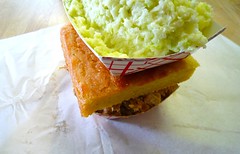High, Low, and In Between, pt. 2, rev. ed.

I'm sure there were some who questioned the sanity of driving 1,800 kilometres (each way!) to spend Christmas in Charleston, but to us it made perfect sense to spend the holidays in the Holy City. And it was definitely something of a pilgrimage.
For one thing, just crossing into South Carolina taken on its own is a big deal, as anyone who's ever made the trek by car down to Florida will tell you: SC is when you start to see the palm trees, and when the air starts to get a bit balmy.
We were also looking for culture, and history, and architecture.
But most of all, we were looking forward to Charleston's renowned cuisine. And if the weather was nice, all the better.
 fig. a: ocean time
fig. a: ocean time
A Charleston, SC primer:
This is a city that contains a truly mind-boggling number of churches and ex-churches,
 fig. b: ex-church
fig. b: ex-church
not to mention an impressive number of Synagogues, all of which are a big part of the reason the city earned its moniker.
Its historic districts are riddled with mysterious alleyways.
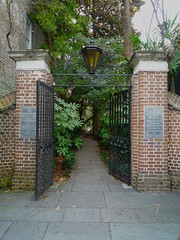 fig. c: mystery lane
fig. c: mystery lane
Its architecture can be quirky,
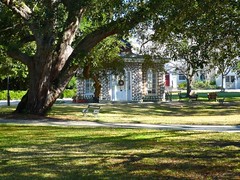 fig. d: shell building
fig. d: shell building
and its cemeteries spooky.
 fig. e: Magnolia Cemetery
fig. e: Magnolia Cemetery
It's a city and a region haunted by its history.

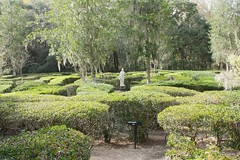
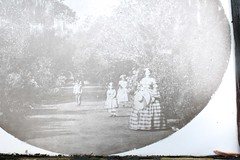 figs. f, g, h: Magnolia Plantation
figs. f, g, h: Magnolia Plantation
It has a very unique landscape, one that is oftentimes dominated by the marshes and wetlands that made it a natural for rice production.
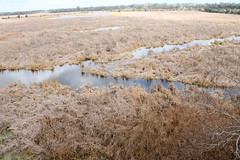
 figs. i, j: wetlands
figs. i, j: wetlands
It's a region of independent-minded characters,
 fig. k: shrine
fig. k: shrine
many of whom we instantly recognized as kindred spirits.
 fig. l: kindred spirit
fig. l: kindred spirit
And it's safe to say that these people are serious about their food, and that the region is positively abundant with fruits, vegetables, legumes, and seafood of all kinds.
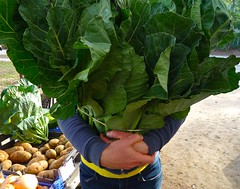

 figs. m, n, o: Ruke's!
figs. m, n, o: Ruke's!
Ruke's, in Mount Pleasant, SC, was our local farmstand. We were astounded by the plenitude we found there--in December!--and we made a point of loading up on collards, black-eyed peas, field peas, butter beans, and pecans before we left.
 fig. p: peas and "peacans"
fig. p: peas and "peacans"
We also loved Ruke's boiled peanuts and quickly got hooked on the habit of throwing our very own Happy Hour at our B & B with some hot boiled peanuts and a couple of ice-cold beers.
Of course, Ruke's wasn't the only local stand offering boiled peanuts. We found them all over the place.
Now, we didn't actually try the boiled "p-nuts" at this establishment, but we did buy some of their insanely delicious raw honey,
 fig. q: p-nuts
fig. q: p-nuts
and we also had quite a run-in there.
 fig. r: squatch!
fig. r: squatch!
If Ruke's was our favourite farm stand, Timbo's was definitely our favourite boiled peanuts cart. His boiled peanuts were piping-hot, they were seasoned to perfection, and the Timbo's experience came complete with a super friendly mascot--Max, the Australian shepherd, who was kind enough to let me photograph him (along with Timbo).
 fig. s: Timbo's
fig. s: Timbo's
And if Ruke's was our favourite farm stand, and Timbo's our favourite boiled peanuts joint, well, there's no question that Martha Lou's was our favourite soul food kitchen.
 fig. t: Martha Lou's
fig. t: Martha Lou's
Martha Lou's is a classic meat-and-three specializing in fried chicken, and we definitely loved their fried chicken, but in many ways it was the "three" that stole the show, especially their luscious butter beans, their smoky dirty rice, their silky collards, their oh-so-satisfying mac & cheese, and their deeply roasted candied yams. Just how good is Martha Lou's? Good enough to go twice over the course of a lightning-fast four-day visit. And the second time we made a point of getting all our favourite sides à la carte--in larger formats. It was worth going back just for those butter beans alone.
 fig. u: The Ordinary
fig. u: The Ordinary
Charleston's Got Mad Skills:
You're obviously taking a risk when you name your restaurant The Ordinary, but if you do happen to knock it out of the park, you'll have people like me quipping that The Ordinary is anything but. The Ordinary doesn't even look ordinary--it's actually a gorgeous, even grandiose seafood restaurant that resides inside a former bank. It's also the latest offering from the people who brought you FIG, one of the catalysts of Charleston's recent culinary renaissance. Put simply, everything was extra-ordinary, from the heirloom pumpkin soup with bay scallops, to the seafood platter, to the breathtaking rice pudding we had for dessert.
McCrady's has to be the restaurant that's most closely connected with Charleston's recent culinary revival. It's the place where Sean Brock first rose to national/international prominence (and where he won his James Beard Award in 2010 as Best Chef Southeast), and where he's still executive chef. But it's also a time-honoured establishment--it began as a tavern in 1778. In spite of a slow start, this was quite possibly our Meal of the Year. Once our sommelière showed up, and we clicked with her over the pleasures of Gamay, things started to happen, and, as a wise man once put it, "if you get in the stream, you are off!" Frankly, everything was great, but standouts included the Calico scallops with roasted butternut squash, chervil, and green peanuts; the trout with Meyer lemon, thyme, and a medley of brassicas (in fact, that the wood-fired cabbage was so totally transcendent that we ordered it a second time); the fall greens salad with charred pecans, country ham, apples and turnips (this was most definitely the Salad of the Year); and the frozen parfait of grits with a bright, juicy, huckleberry coulis, which was both dangerous, and dangerously delicious.
Butcher & Bee is the new-fangled luncheonette of your dreams, featuring phenomenal bread (they do the bread & biscuits baking for McCrady's and Husk), an enticing line-up of sandwiches (like their pimento cheese and country ham combo), and some wonderfully creative (and tasty!) salads (including their magnificently vibrant kale slaw). Great selection of sodas, too, including Michelle's Soda of the Year: Mr. Q. Cumber (guess the flavour!).
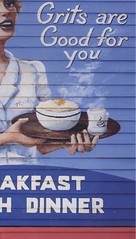 fig. v: yes, they are!
fig. v: yes, they are!
The Hominy Grill is a full-service restaurant that does a brisk trade in breakfast & brunch and that serves a definitive shrimp & grits plate, as well as an amazing biscuit & sausage gravy plate, and some wicked-looking Big Nasties.
If you're looking for barbecue in Charleston itself, the local branch of Jim 'n Nick's Community Bar-B-Q is the place to go. It's exactly the kind of new-fangled barbecue establishment you wish you had in your hometown, because in spite of any ironic old-timey-ness they might be selling, these guys take their barbecue seriously, the results are sultry 'n' smoky (check out those spare ribs!), and they've got all the sides and the fixin's down pat, too (from their slaw, to their slow-cooked collards, to their mac & cheese). After all, Jim 'n Nick's comes with a pedigree--they're a crucial part of the Fatback Collective team of old-school barbecue aficionados, and, therefore, very well connected.
 fig. w: nightcap at the Belmont
fig. w: nightcap at the Belmont
Our favourite place for a nightcap was The Belmont.
The best (and cutest) sweets shop we encountered was Sugar Bake Shop, whose cupcakes, cookies, and iced tea were all superlative.
 fig. x: home comfort
fig. x: home comfort
And Page's Thieves' Market in Mount Pleasant was definitely our favourite antiques shop of our trip. It was also the friendliest, the one with the most character, and the one that was the most kitchen-friendly. And it had the best name, too.
In a sense, my title is a little misleading, because in Charleston and environs, when it comes to food, distinctions between high, low, and "in between" aren't nearly as rigid as they are in so many other places. This is a region that self-identifies as the Low Country, after all, and traditional ingredients, like grits, golden rice, and peanuts, and preparations, like corn bread, appeared repeatedly during our stay. In fact, everywhere we went, the overwhelming sensation was one of pride in the local cuisine. And, frankly, that's our kind of town.
Particulars:
Ruke's farm stand, right next to the Holy Trinity AME Church, 378 Mathis Ferry Rd., Mount Pleasant, SC
Timbo's Boiled Peanuts, 2484 Ashley River Rd., Charleston, SC
Martha Lou's Kitchen, 1068 Morrison Rd., Charleston, SC, (843) 577-9583
The Ordinary, 544 King St., Charleston, SC, (843) 414-7060
McCrady's, 2 Unity Alley, Charleston, SC, (843) 577-0025
Butcher & Bee, 654 King St., Charleston, SC, (843) 619-0202
Hominy Grill, 207 Rutledge Ave., Charleston, SC, (843) 937-0930
Jim 'n Nick's Community Bar-B-Q, 288 King St., Charleston, SC, (843) 577-0406
The Belmont, 511 King St., Charleston, SC
Sugar Bake Shop, 59 1/2 Cannon St., Charleston, SC, (843) 579-2891
aj

